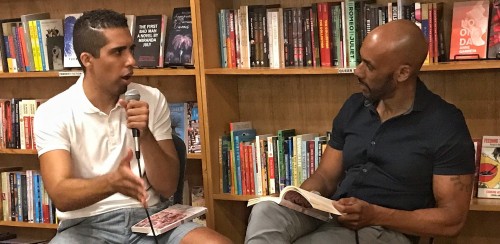A big buzzword of the moment is intersectionality. As an editor at POZ, I hear it everywhere, from on-the-street activists to behind-the-scenes academics. In very loose terms, it’s a theory, originated by Kimberlé Crenshaw, that explores how social identities overlap and create multiple interconnected systems of discrimination. For example, think about the different types of challenges facing an HIV-positive Black lesbian living in poverty in the rural South.
Intersectionality has its supporters and haters alike, particularly with regard to fighting discrimination. Does its expansiveness bring diverse factions closer together and make them stronger? Or does it further divide us through identity politics?

Clay Cane and Keith Boykin at Bluestockings bookstore in New York CityTrent Straube
Regardless, I kept thinking about the topic as I read Clay Cane’s collection of autobiographical essays Live Through This: Surviving the Intersections of Sexuality, God and Race. He’s gay, has a white mother and a Black father, and grew up in poverty and in the Black church; the latter is the subject of his 2015 documentary, Holler If You Hear Me: Black and Gay in the Church. More important, he’s a talented and insightful journalist willing to report on his own life (full disclosure: Cane and I were colleagues nearly a decade ago at HX magazine, a weekly gay entertainment guide to New York City).
At the book’s beginning, he writes: “As I grappled with various identities and survived hostile environments, in my lowest moments, I would ask: ‘Can I live through this?’ I did. My lifeline for survival was understanding the nuances of race, class, gender, sexuality, and faith. My very being exists in intersectionality.”
His strength and success lie, in part, in his ability to bring those identities and intersections out into the open, refusing to hide any of them. He divides the essays into five categories: sexuality, love, race, God and intersections. But he never gets bogged down in the theoretical and the analytical. That would be a bore. Instead, he uses engaging storytelling to let you know what it’s like to actually experience a life of intersectionality. He navigates the diverse and nuanced subjects with a voice that’s clear, accessible and inviting, even when the stories turn dark, such as when he describes his father’s violence or the time a (white, older, heterosexual) doctor shamed and terrified him by saying the acne on his face was probably from AIDS, a conclusion the doctor apparently made after learning that Cane was gay (you can read a related excerpt from that chapter, titled “I Am HIV,” here).

Clay Cane, author of “Live Through This”Cane courtesy of Ken Marcelle
The titles of other essays give you a pretty good indication of what to expect: “The First Time I was Called a Faggot,” “Pop Life,” “The Whole Town’s Laughing at Me,” “Tragic Mulatto,” “Divas Live: Beyoncé, Mary, and Patti” and “Church Queen,” to name just a few.
But there’s a lot of fun stuff too. As a white middle-age gay dude, I was surprised at how often I related to Cane’s story, particularly when I read of his mom’s obsession with Prince during his purple reign and of Cane’s own love and appreciation for Madonna—whose Truth or Dare documentary was a gay touchstone and recently became an HIV touchstone too. Live Through This also offers a good dose of inspiration.
In writing the book, “my intent was to free somebody a little bit, the way Prince freed me,” Cane recently explained to journalist Keith Boykin at a Q&A at Bluestockings bookstore in New York. (During their conversation, I learned that the book’s title also references the 1994 album Live Through This by Hole, released a week after the band’s lead singer Courtney Love’s husband, Kurt Cobain, died.)
But let’s get back to Cane and intersectionality. “I can’t dismiss the residue of poverty, losing friends to HIV, the blows of words like nigger and faggot, or surviving spiritual violence,” Cane acknowledges in an essay about his abusive father. “This is not a tale of ‘I moved on and now I’m fabulous!’ We carry the past and the present. The scars of our past are a piece of our intricate imperfections. These experiences not only form who we are; they shape our fears and burdens. That’s the other part of intersections—they’re not solely the identities, they’re the fights we may never win, which are unavoidable in the journey.”
That journey, as Live Through This illustrates, can be lightened by sharing our stories.

Keith Boykin and Clay Cane at Bluestockings bookstore in New York CityTrent Straube








1 Comment
1 Comment